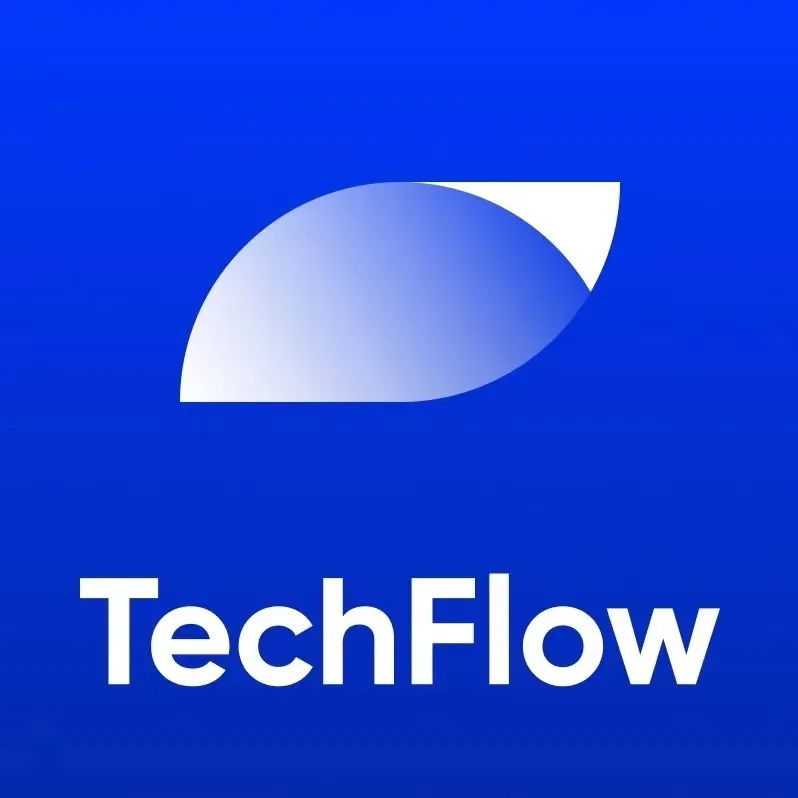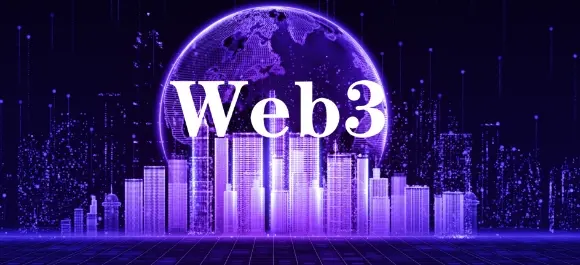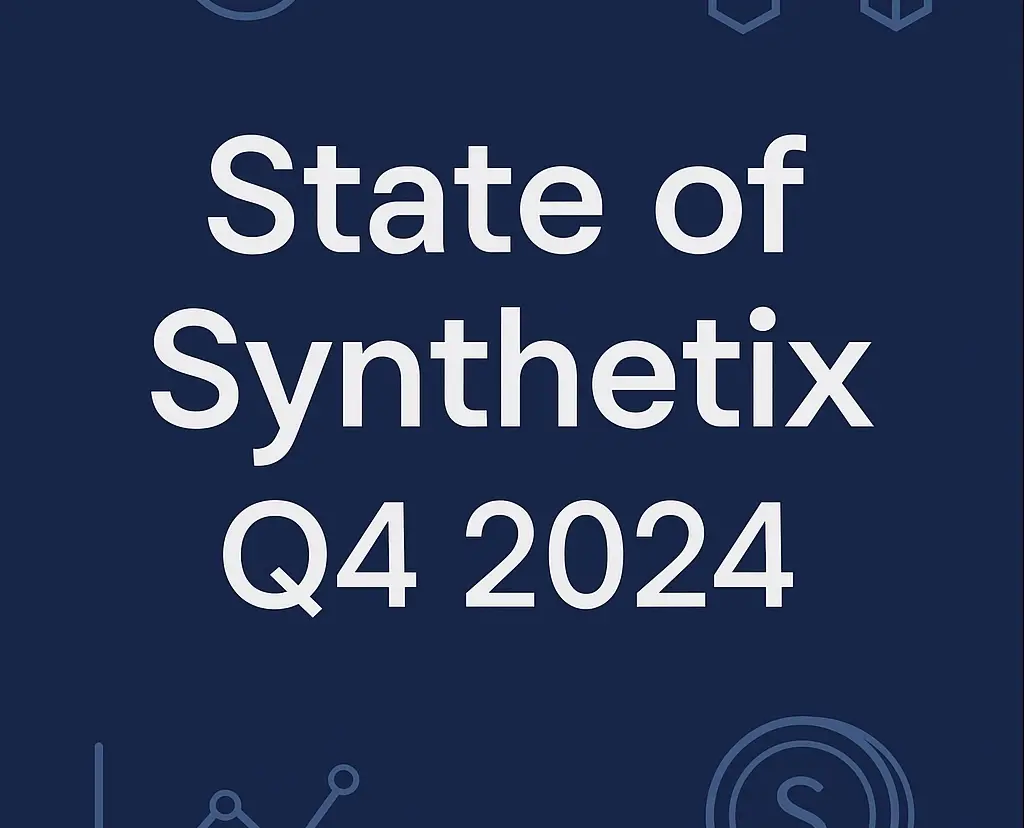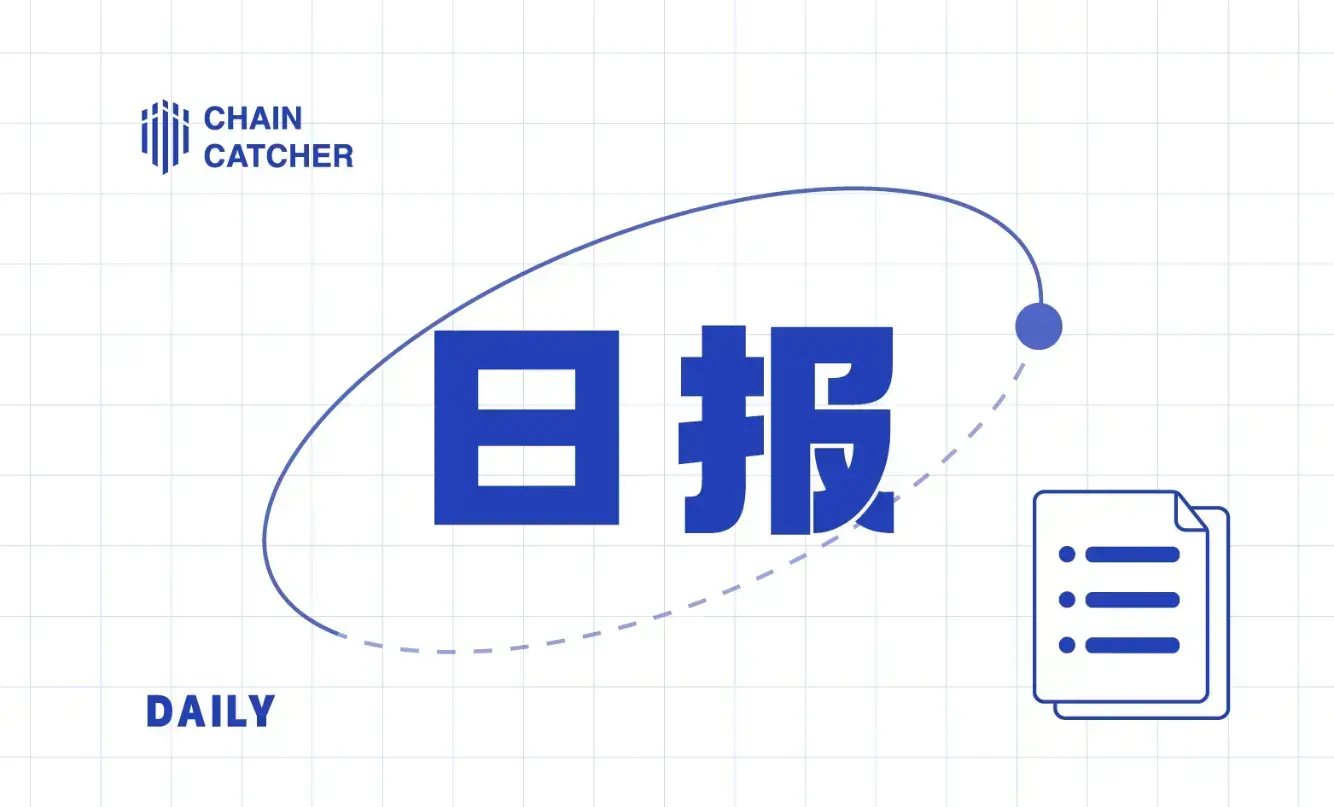ETH Denver Conference Reflections: DeFi is No Longer the Only Use Case for Crypto, ZK Remains an Important Narrative
Original author: CRV.MKTCAP.ETH
Original compilation: Deep Tide TechFlow
The ETH Denver conference was recently held, and it was massive, even larger than ETH-CC.
As a result, the entire event essentially turned into a "choose your own adventure" experience, allowing you to create your own information bubble.
We had a better idea to capture a broader experience. We asked everyone we interacted with during the conference to submit their experiences. Most people told me to go away, but 21 were willing to share their insights.
Here are their narratives.
Scoopy Trooples, Founder of Alchemix
ETH Denver is a huge celebration.
We have emerged from the bear market, and friends and colleagues are coming together, excited about what we are building and the future of our industry.
With each bear market we endure, our connections grow stronger. The massive developments happening within the Ethereum ecosystem are astonishing, and honestly, the pace of progress is hard to keep up with.
We thank everyone who attended the Alchemix event co-hosted with Rare Evo, Premia, Silo, and Certora. See you next year, Denver.
LogarithmicRex, Member of StrangeH 2 OPod
ETH Denver once again delivered on its promise: bringing the Western crypto community together for face-to-face interactions. It's hard to overstate the importance of in-person meetings for this industry, perhaps because we are more accustomed to online events. No other event can match ETH Denver in terms of density and energy.
Specifically, the main takeaway from ETH Denver 2024 is that much of the energy this week shifted from the main event to single-day/half-day smaller meetings, and I might even say there were too many small meetings. Everyone felt they missed something important. The main event was also affected, being much smaller in scale, with booths that were less eye-catching. I wonder how long ETH Denver will maintain its dominance.
Finally, I noticed that this year's energy was more focused on infrastructure and ZK; while DeFi still has a strong presence, I am starting to see signs that we are moving away from the "DeFi is the only use case for crypto" era.
DeFi Dave, Member of Flywheel DeFi
My two takeaways are:
DeFi as a sector within crypto is maturing and evolving rapidly. Conversations at the Stable Summit largely revolved around RWA, and you will see more institution-friendly projects and participants emerging. It may not be as wild as before, but it is more sustainable, indicating that as long as we can maintain an open, positive, and collaborative core spirit without bowing too much to the old world, we can grow.
Crypto x AI is not a gimmick; it’s a real synergy. Just as blockchain enabled self-sovereign currency, it also enables self-sovereign intelligence. As the risks of centralized AI threaten our privacy and our children's understanding of the world, this becomes increasingly important. I hope we have time to correct this, but for now, don’t shy away from AI discussions and conduct due diligence on valuable efforts, as it will be in our best interest.
Jack Melnick, DeFi Lead at Polygon
Main takeaway: The energy in Denver is better than it has been in years. People are clearly ecstatic after emerging from a long bear market and are enjoying the exploration and creativity that comes after a long period of heads-down building (myself included!).
My favorite part was exploring some new areas that are clearly going to be major themes of this cycle:
Native yield
Rollups/L2
Cross-chain messaging/modular interoperability
PVP games and new Ponzi economies
More thoughtful consumer-facing products
A plethora of new DeFi applications
One of my biggest takeaways is that we have too many generic L2s. Ultimately, the sequencer fees for these generic chains will trend toward zero over a 3-5 year horizon or even longer.
Therefore, you should really hope to achieve some level of specialization, whether as an application chain or as a vertically specific chain, rather than competing in the same space as everyone else. A million identical L2s will only lead to fragmentation, no matter how you slice it.
So, as an extension, I think what I found most interesting was jamming with smart people at the conference who are clearly motivated to contribute again after being drained in the last cycle. I think in two days, we probably came up with over 25 new CDK chain ideas, all of which have a high degree of specialization.
Darren Camas, CEO and Co-founder of IPOR Labs
ETH Denver is a mixed bag; market sentiment is somewhat excited, but there is an oversupply of infrastructure and insufficient representation of DApps and end-users. I was shocked to see the prevalence of infrastructure projects from L2 to DApp chains to cross-chain infrastructure around the main venue.
What’s missing are users engaging in on-chain activities beyond memecoin speculation. This reflects VC investments in infrastructure, where the best DApps can yield multiples, but infrastructure can achieve billion-dollar valuations. I can’t help but compare it to building a ghost town, where everyone buys property, all the roads are paved, and the sewer lines are installed, but no one lives there. When people start selling their ghost town properties, we will see the economy contract back to safety.
My main point of interest is the narrative around re-staking. As LRT siphons liquidity away from DeFi, re-staking is inevitable, as the space has over-leveraged points while neglecting returns and, more importantly, ignoring risks. Some major LRT protocols claim to be participants in the emerging bond market, with different investment grade characteristics and structures, from market platforms to highly curated validator sets.
Our work at IPOR Labs is to understand, quantify, and contextualize the risks associated with interest rates or re-staking rates. Therefore, the current lack of data availability is a huge opportunity, but it is also a significant challenge and risk assessment, while most people in the market remain oblivious. I suspect there may be several significant capital losses before the market fully prices in re-staking opportunities. This is where the IPOR protocol comes in, as it will become a credit default swap market similar to LRT.
Corey Caplan, Founder of Dolomite_io
Overall, it was a strong conference. Although I think the recent price action would attract more "moon boys," it actually encouraged more builders to attend. A lot of innovation is happening, and the entire industry is eager to work together to drive progress.
I also noticed that people are more focused on risk management and generally have more self-awareness about what is being built and how to introduce risk.
Eomji Park, Head of Research and Operations at Encode Club
ETH Denver showcased the resilience and vitality of the community, persisting through the bear market. The highlight of the event was those steadfast builders deeply involved in technological innovation.
The focus remains more on infrastructure rather than applications, and it is striking to see the lack of engaging applications. There is a general recognition of the need to bring more developers into the ecosystem, but there is a shortfall in sustaining this growing influx of activity and opportunities. Addressing this issue is the responsibility of every participant.
Despite the challenges, the presence of smart and passionate individuals dedicated to advancing web3 is a source of inspiration. Their efforts may have an impact beyond the boundaries of web3 into other technological fields.
Wavey 0x, Core Developer at Yearn Finance
We are still in the early stages. The technologies that people are hyping are not all ready for practical application.
As always, the best part of ETH Denver is the people here. Interacting with those who are delving into the same DeFi niches as you is the best.
Prioritize meeting people rather than spending time on the main events.
Additionally, I think EigenLayer is overrated.
Marco Worms, Documentation at Yearn Finance
The ETH Denver hackathon is a significant driver of EVM talent, and in my view, the best part of this event is meeting with technologists.
Despite the U.S. struggling with cryptocurrency, events like this show that Americans still seem to be trying to stay at the forefront of the market, with many excellent developers attending this event, and I’m glad to be here.
Navy Innovator
ETH Denver felt quieter than last year, which is somewhat surprising. I’m not sure why, but as an experience, it was better because many talks had dozens of attendees (or fewer), making it easier to talk to the speakers afterward. I love meeting people at conferences and think that’s the best part, but I don’t need to meet 25,000 people, and a smaller crowd makes me feel less fatigued.
This year, AI was more prominent in the talks, even more so than at ETH CC six months ago, when account abstraction was a major focus. In one talk, the speaker launched a permissionless GPT in five minutes, utilizing idle A100 resources for rent. Crypto gaming and Farcaster were also major talking points.
Bitcoin enthusiasts were out in force, and it seems there is finally a lot of building happening on L2. We love to see this; the best decentralization includes multiple technologies.
Overall, the field is growing, and developers are becoming more niche, even in subcategories like DeFi based on Curve, where it’s impossible to keep up with everything. The significance of ETH Denver lies in making friends; it makes the entire crypto experience more meaningful than just numbers going up (though we also enjoy numbers going up).
Figue, Member of Paladin Vote
This conference is a perfect example of a calm ending and the beginning of a storm. Every project is in launch mode, and people are getting excited again. New users are finally back, and there is real institutional interest, which is much more advanced than simple attempts.
I see something; this year is going to get very crazy.
Billy, Co-founder of Term Labs
Seeing BTC soar to $60,000 on my flight Wednesday morning, I knew there would be a lot of energy. The good vibes and optimism among builders were almost as high as the price.
In addition to the price surge, major themes included: founders discussing successful fundraising, LPs wanting to deploy more capital in DeFi, EigenLayer changing the landscape of Ethereum, LRT, risks associated with launching on AVS, points people are mining, what Ethena's success will mean for perpetual interest rates, the launch of Blast, the huge shifts in Bitcoin ordinals, and the promise of Bitcoin becoming more expressive through L2.
Derek, Validator at Certora
This year's ETH Denver was bustling compared to last year. There were numerous off-site activities, a plethora of new protocols and startups, and a large number of institutions that have weathered the trials of the crypto winter. The energy of the conference seemed to match the significant rise in BTC and ETH prices during the same period. The winter is over, and we are in a thriving crypto spring.
What intrigued me most was the aesthetic of the venue, companies, and attendees. This year felt more corporate in some ways than previous crypto conferences I’ve attended. The 80s aesthetic of Curve.fi's web interface is outdated, replaced by a stylish, clean, Apple-like corporate aesthetic (especially since Coinbase set up a booth that felt like an Apple store). Companies are growing in terms of adoption, revenue, legitimacy, and entry into mainstream culture.
Most importantly and joyfully for all of us, we are still filled with extremely smart and proactive builders. The previous hype bubble seems to have mostly dissipated, and most of the ideas I encountered at this conference were genuine, research-based innovations, from ZK proofs and verifiable computation to Rollup-based scalability and interoperability, to formal tools for auditing and formal verification. The aesthetic may be playful and informal, but we are here and building real things.
Kostiantyn, Head of Fintech Products at Dev.Pro
Stablecoins now have risk characteristics, so anyone will find something that meets their needs:
Circle: conservative, does not share profits with holders
Ondo: conservative, but shares profits
Ethena: carnival mode, offering a 25% annual interest rate
USDT + USDC = 96% of stablecoin market cap = industry and its decentralized risks. It shouldn’t be like this.
Tokenization in 2024: Treasuries and stablecoins will dominate trading volume. Real estate and art will lead innovation.
Interoperability is key. Blockchains and protocols should be able to transact seamlessly.
In 2024, Asia will become the main driver of blockchain and cryptocurrency.
Institutions are catching up: Citibank has conducted digital asset pilots, and JPMorgan executes billions in daily trading volume.
Industry agnosticism? Can we really achieve industry agnosticism today? - Uncertain.
Private networks are a thing of the past. Today, public networks with permission and privacy levels have become a reality.
Simply building technology is not enough. Getting regulators to approve this technology is a big deal.
RWA is not actually a retail product. In a bull market, retail is not interested in a 5% annual interest rate. In a bear market, that will change.
Prediction (or hope) that the U.S. will regulate stablecoins in 2024.
In 2017, the promise of tokenization was better liquidity. Today we see that this is not the case. Liquidity has improved, but it is not good; things that have poor liquidity in the real world still have poor liquidity on-chain. The true meaning of tokenization lies in efficiency, cost optimization, speed, transparency, and security.
Tokenization is beneficial for things that can only exist in the physical world, while things that can be digitally native should be digitally native. Currency is a great example; it should ultimately become something digitally native rather than tokenized.
A new generation of digital natives is about to emerge, accustomed to the speed, convenience, and low cost of the digital world. Imagine what will happen when they try to open a U.S. bank account and pay a 3% wire transfer fee and wait five days for it to arrive. They will resist, which will further drive blockchain adoption.
Alan Scott, Admin of RAILGUN_Project
My interactions with crypto enthusiasts and builders are usually online. On Discord, Telegram, Twitter, and if I’m lucky, some video calls. This is what makes conferences like ETHDenver so appealing, where hackers, speculators, and venture capitalists come to a city to share their adventures in this field.
I’m still trying to digest the "alpha" from this week. Talking amidst the deafening music and giving talks at the conference. One thing is for sure: memes are back in full swing. $MOG, $PEPE, $WIF, random NFT collectibles, everyone has their own exciting thing to promote. I still find it amusing that some are trying to find a way to "invest in Bera." All of this tells me that people are getting excited about speculation again.
The real reason I came here was to meet other developers in the field. Most interesting conversations happened during quiet lunch breaks. The most thought-provoking discussions I had were about privacy, smart contract design, malicious holders, and more.
In summary, I am most interested in web3 security-type protocols, especially those claiming to be able to preempt malicious trades. Additionally, there are wallets with trade simulation and rapid response alert features for identifying traps and efforts to aggregate information from various companies to better serve the community. More end-user security means (hopefully) more adoption, but it makes me feel that it might lead to worse architectures, like sending millions of dollars to anonymous multi-signature accounts due to hype.
I have a love-hate relationship with ETH Denver. I’m a bit annoyed at playing "Lu.ma Go Fish" with my "online friends." The lack of Uber and expensive food is somewhat disappointing, but I know I will come back again. Thousands of like-minded people gathering in the same city is almost indescribable.
Zach, Founder of Party Action People
We were very surprised by the response to the unStable Summit. Nearly 600 people attended, with representatives from almost every major L1, L2, stablecoin, and lending protocol. An obvious takeaway is that serious people believe stablecoins and RWA are key narratives.
As this was my first time attending the broader ETHDenver conference, I finally understood why there is so much hype. These two weeks were among the most productive conference weeks we have attended, with everyone here. Denver is also an amazing city, and we caught some good weather.
Taariq Lewis, Member of Volume Finance
My conclusion from ETHDenver is that we are competing for "higher-yielding ETH"! What would the world look like when every ETH is trying to outperform regular staked ETH for the highest yields and points?
ETH Denver showcased some LRT and LST activities that attracted a large audience, with the founder of EigenLayer being humorously referred to as the "Brad Pitt of crypto." Driven by security and financial leverage, the race for the highest-yielding ETH has begun.
Aiham, Founding Team of Silo Finance
ETH Denver was a huge success. Most members of Silo's core contribution team met for the first time since SiloDAO was established. We met with many partners, users, and community members, which was especially important for our engineering team, as they rarely interact with the community.
Our takeaways:
We received a lot of love from teams, projects, and the entire community, which will inspire us to better serve the DeFi ecosystem.
For the first time in two years, we felt an incredible positive sentiment towards the entire ecosystem.
Innovation has returned to the ecosystem.
Tao, Member of Aladdin DAO
This is my second time attending ETH Denver.
The first time, I attended as a developer. The main conference was not well-prepared, as the internet connection was poor and the food was expensive. However, many hack houses encouraged the developer community, especially the Huma Finance hack house. They provided free coffee, free food, fast internet, and prizes; they clearly knew what developers needed. I want to thank them for making ETHDenver more welcoming.
This year, I took on more of a business development role at Aladdin Dao, promoting our latest product, f(x) Protocol's $fxUSD. This was also my first time speaking at the Unstable Summit. I was excited to meet all the DeFi enthusiasts.
Although DeFi may not be the hottest topic this year like AI or BTC Layer 2, the entire DeFi industry is still growing rapidly.
Samuel McCulloch, Member of Flywheel and Leviathan News
Everything about ETH Denver can be summarized with this chart showing the amount of VC funding per month over the past three years.
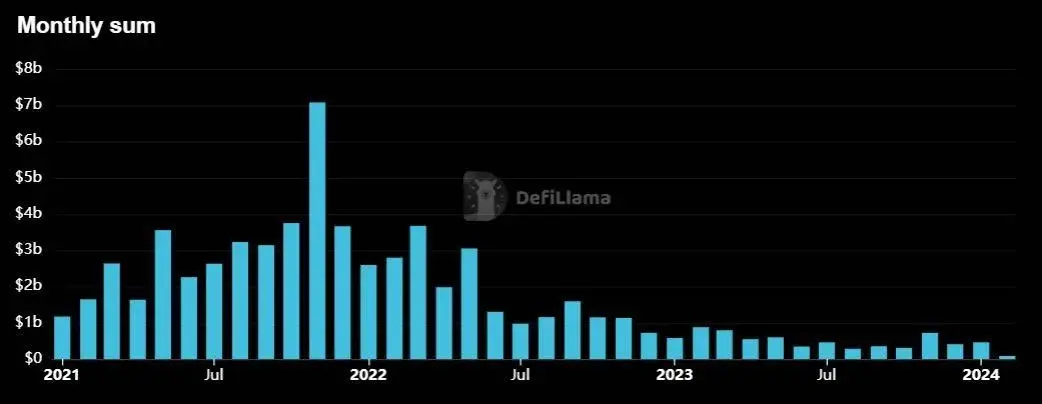
After peaking in 2021/2, new funding for projects has essentially dried up, and the impact on the largest crypto event in the U.S. is evident. The lavish parties have disappeared (except for Berapalooza), the number of booths at the main event has decreased, and the number of participants has dwindled.
Low-key. That’s how I feel about this year’s ETH Denver. Despite prices hitting all-time highs, new funding has not flowed into major projects at the scale we saw in the last bull market. I guess we are still shadowed by the aftermath of FTX's bankruptcy, and U.S. regulation is no better than before. DeFi is not a major narrative this year; it’s AI and re-staking. The former has yet to be tested and has not gone through a cycle, merely relying on Open AI's $7 trillion valuation. The latter is just an industrial-scale airdrop with no revenue and use cases, a billion-dollar airdrop farm.
That’s not to say things won’t change, but the calm sentiment towards cryptocurrency this week has been fully reflected.
Alex Golubitsky, Founder of MetaLeX
Another great ETH Denver! Although I bought a ticket for the main event, I never successfully attended the conference itself. The off-site activities were, as always, fantastic. The biggest takeaway I got from this event is:
Governance is the primary focus of projects
Stablecoins have generated immense interest among market participants, and people are interested in basis swap-priced stablecoins
ZK remains an important narrative
Interest in L2 and alternative L1s remains high
As for the conference itself, I’m most concerned that it is no longer a single event but a series of related events. While the quality of related events may be the highest ever, I worry that the community is becoming insular, and as a result, opportunities for collaboration between groups that don’t interact frequently are diminishing.


